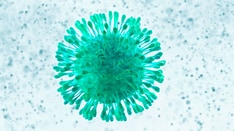Researchers are conducting the first-in-human trial of a universal influenza vaccine candidate, the National Institutes of Health (NIH) announced April 3.
The NIH's National Institute of Allergy and Infectious Diseases (NIAID) hopes to develop a vaccine that will overcome the challenges associated with seasonal changes among influenza strains.
"Seasonal influenza is a perpetual public health challenge, and we continually face the possibility of an influenza pandemic resulting from the emergence and spread of novel influenza viruses," Anthony S. Fauci, MD, director of NIAID, said in a news release. "This phase 1 clinical trial is a step forward in our efforts to develop a durable and broadly protective universal influenza vaccine."
The trial will examine the safety and tolerability of the vaccine (H1ssF_3928) as well as its immunogenicity in healthy volunteers.
The vaccine stimulates protective immune responses against very different influenza subtypes by homing in on an area of the virus that remains relatively constant from strain to strain. The vaccine candidate development is part of a larger initiative to develop a universal vaccine candidate that can provide durable protection for individuals of all ages and against multiple influenza subtypes, including those with the potential to cause a pandemic.
Grace Chen, MD, of the NIAID's Vaccine Research Center (VRC) Clinical Trials Program, is leading the study at the NIH Clinical Center in Bethesda, Maryland. The trial will gradually enroll 53 or more healthy adults aged 18 to 70 years. The first five participants, aged 18 to 40 years, will receive one small intramuscular injection (20 mcg) of the vaccine to test its safety.
The remaining 48 participants will be given two 60-mcg injections spaced 16 weeks apart; these participants will be stratified info four age groups of 12 participants each: 18 to 40 years, 41 to 49 years, 50 to 59 years, and 60 to 70 years. Researchers will study whether and to what extent their immune responses vary on the basis of age and the probability of their prior exposure to different variants of influenza.
Participants will document their temperature and occurrence of symptoms for 1 week following each injection. They will not be exposed to influenza as part of the study but will periodically provide blood samples that will undergo testing to characterize and measure anti-influenza antibody levels. Nine to 11 follow-up visits will be conducted over 12 to 15 months.
"This phase 1 clinical trial is the culmination of years of research and development made possible by the unique collaborative setting that the VRC offers by bringing together top scientists, manufacturing expertise, and an outstanding clinical team," VRC Director John Mascola, MD, said in the news release.
Longer-Lasting Immunity
"A team of VRC scientists developed the universal influenza vaccine prototype. It displays part of hemagglutinin (HA), an influenza protein, on the surface of a microscopic nanoparticle made of nonhuman ferritin. Ferritin is a natural protein that can be found in cells from all living species. It is useful as a vaccine platform because it forms particles that can display multiple influenza HA spikes on its surface, mimicking the natural organization of HA on the influenza virus," according to the news release.
HA allows the influenza virus to pass into a human cell; it contains a head and stem region. Although the body can mount an immune response against both regions, most of it is focused on the head. The HA head constantly changes or undergoes "antigenic drift"; therefore, the new vaccine candidate only contains the HA stem, making it less likely to need updating each season. By focusing on the HA stem, the researchers believe the new vaccine candidate could provide wider and longer-lasting immunity.
To create the vaccine candidate, researchers used the stem of an H1N1 influenza virus. H1 describes the virus's HA subtype and N1 describes the neuraminidase subtype. (Neuraminidase, or NA, is another influenza surface protein.) Eighteen HA subtypes and 11 NA subtypes are currently known; however, only H1N1 and H3N2 circulate among humans seasonally. H5N1 and H7N9 as well as other strains have caused a few lethal outbreaks and could potentially cause a pandemic if they become able to spread more easily.
The fact that the H1N1 candidate vaccine was effective against H5N1 infection — a different influenza subtype — suggests the antibodies the vaccine induces can be protective against other "group 1" influenza subtypes, including H1 and H5. Future clinical trials will evaluate a vaccine against "group 2" influenza subtypes, including H3 and H7.
An earlier VRC trial of a ferritin nanoparticle vaccine that included both the hemagglutinin head and stem demonstrated the platform is safe and well-tolerated when used in humans. Consistent with all clinical trials, a protocol safety review team will routinely evaluate vaccine safety data in the phase 1 study participants.
Enrollment for the trial is expected to be completed by the end of 2019 and results are anticipated beginning in early 2020. Additional information is available at ClinicalTrials.gov (NCT03814720).
Follow Medscape on Facebook, Twitter, Instagram, and YouTube.
Medscape Medical News © 2019
Cite this: First Human Trial of Universal Flu Vaccine Underway - Medscape - Apr 04, 2019.






